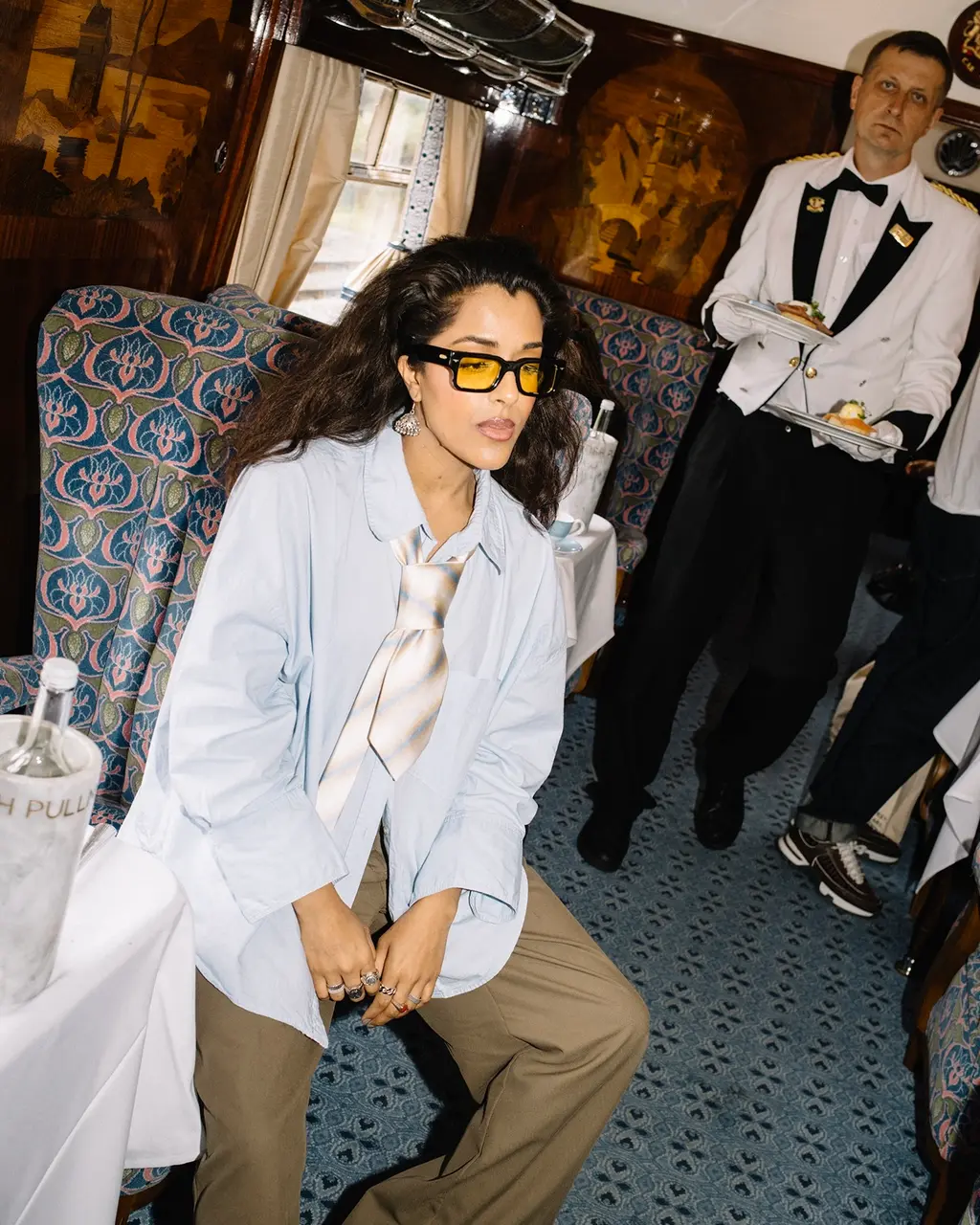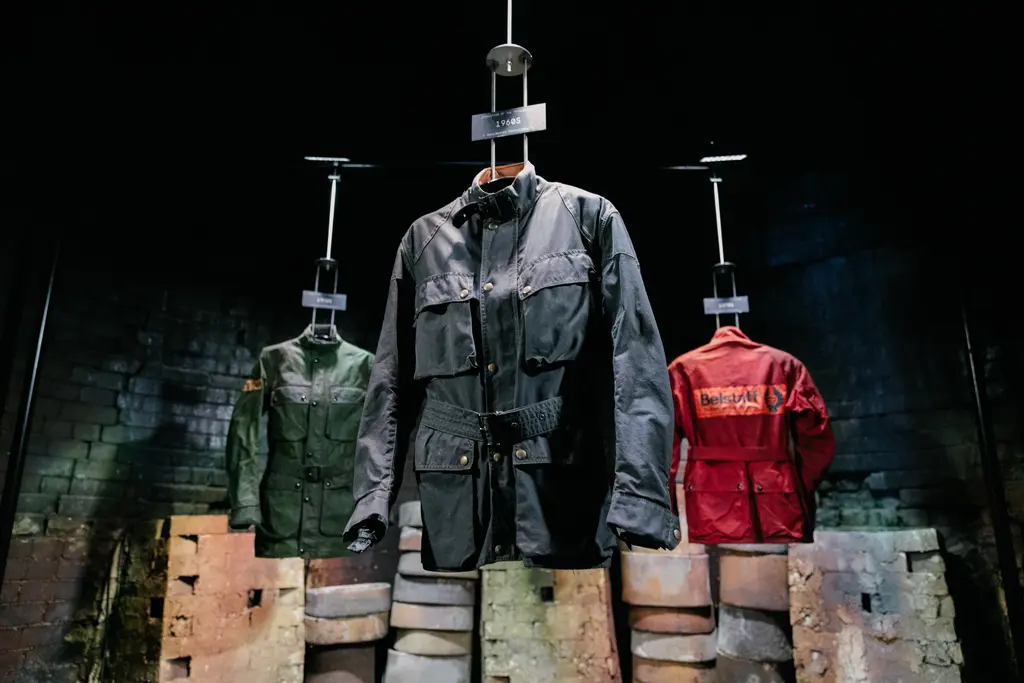Belstaff delves into the archive to celebrate 100 years

Last month, the British heritage brand chartered a train to take 150 guests to where it all began: Longton, Stoke-on-Trent, the home of the Belstaff’s original factory and the people who made it what it is today.
Style
Words: Olive Pometsey
Longton, Stoke-on-Trent. Population: 27,214. Number of heritage brands founded in the town: exactly one – Belstaff, to be precise, which is celebrating its 100 anniversary this year.
That’s precisely why 150 influencers, fashion journos and stylists temporarily upped sticks to Longton last month. They arrived in style, naturally, on board a specially chartered Belmond train – you know, those Agatha Christie-style ones that serve champagne bellinis from 8am – that dropped them off in the town centre, ready to be picked up by some equally old-timey buses.
Their final destination: the Gladstone Pottery Museum, where Belstaff was hosting a special archive exhibition, Our First 100 Years. Delving deep into the brand’s history via an archive of perfectly weathered Belstaff jackets, coats and even tents, the exhibition charted how the business grew to become a leader in all-weather clothing, in particular its influence in both motorcycling and normal cycling. Take, for example, the room that was dedicated to the brand’s Trialmaster jacket, complete with footage of athletes peddling it out at major sporting events, as well as a well-loved piece that once belonged to Steve McQueen.






After a good nosey around the exhibition and a portion of chips at the museum’s caff’, the Belstaff team rounded up guests and sat everyone down to announce the winner of their inaugural Cloudmaster project. In partnership with Manchester Met’s Fashion Institute, the newly launched talent incubator and prize fund is designed to find and support the next generation of designers. After a panel discussion with the project’s judges, Hadisa Ahmad Tabussam was crowned the winner, with Ari Nendran, Eloise Ford and Freya Lucas named as runners up. Celebratory drinks were drunk, then it was all aboard the Belstaff express back to London.
But the party in Longton didn’t end there. The next day, Belstaff hosted a reunion event for ex-factory workers who helped build the brand into what it is today – pick up the brand’s new coffee table book (also titled Belstaff: Our First 100 Years) and you’ll be able to read all about their stories, from the families who worked there across generations to the families that started as factory floor romances.
Because, as Belstaff’s Chief Brand Officer Jodie Harrison can attest to, this is a brand that’s as passionate about its community as it is about its clothes.



Hey Jodie! 100 years is a massive milestone. Where do you even begin when planning a celebration like this?
We started two years ago and we wanted to provide a sustained campaign across the whole year, so every month there’s something else, basically. But this was obviously the crescendo from an event perspective. This day seems quite easy, but it’s been a lot of logistics!
There’s so many brilliant archive pieces in the exhibition. How did you a) source it all and b) whittle down what to include?
The whittling down was challenging, because obviously, we’re passionate about everything that we’ve done in the past. George May, our in-house designer and curator for the archive, worked really hard on the curation. We have borrowed pieces from global collectors, including customers and former CEOs – the really badged Trialmaster jacket was our former CEO Gavin Haig’s. So we have begged, borrowed and stolen from a lot of people. But we also spent a lot of time in the last year buying back a lot of archive [pieces]. And there was a big piece of work done in 2014 by Doug Gunn, who curated about 150 pieces specifically for us to have – at that point, we only had, like, 24 items, so it’s been a 10 year project, through different people, owners and management teams. Now we’re really focused on buying back as much as we possibly can to preserve it for the future.
Do you have any favourite pieces in the exhibition?
I love Gavin’s jacket, because I’m a real moto head and that really speaks to the tribalism of the 59 Club and the rockers of the ‘50s, who went out on a Saturday to race together, went down to the Ace Cafe and all wore their badges. There’s a story in every badge that’s on that jacket. I don’t like a preserved archive piece that hasn’t done anything. As new garments that still have the tags in them, never been worn – that to me is like a vintage car that’s never been driven. It’s against what it was created for.

Why was it important to include a reunion for ex-factory workers in Belstaff’s 100 anniversary celebrations?
In any business, there’s the people that get stuff done, and they are very rarely celebrated. And for me, the culture I discovered through interviewing a lot of the people that used to work for us in Stoke-on-Trent, who are now 70 to 80-years-old, they absolutely loved working with us. They made friendships for life and married people from there – it meant something. So for us to honour that, celebrate them and allow them to come back together and share memories [is important].
How did you find those people to interview and feature in the book and tomorrow’s event?
We put a lot of ads out on Facebook groups and then it was like a trickle effect. Once you found a couple, they knew people or had a relative here or there, so it’s really a hunt! A lot of them aren’t digital, they don’t have email, so it was through phone conversations and actually having to go and see them in person. In the book, we wrote about four or five people who used to work for us who are now in their 80s. The stories that they told are honestly, heart-wrenchingly beautiful, so lovely. And that’s what makes me love this brand. I just adore what it’s meant to people.
Didn’t make it to Belstaff’s Our First 100 Years exhibition? Fear not. You can still check out the whole thing here.










